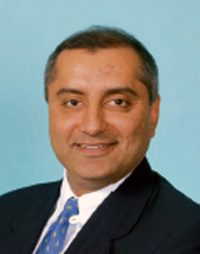|
New Delhi. Raytheon, the leading US
arms technology company, is looking forward to
supplying the sophisticated Patriot Anti Missile
Missile System to a dozen countries, including
India.
According to Sanjay Kapoor, the newly-appointed
Vice President of the company’s Patriot Program,
the system is “Tried, Tested and Trusted”
by 10 countries already and that “there was
considerable interest in another dozen countries
for the simple reason that this was the only system
available today which had been fi red extensively
both in trials and war.”
 In
a telephone interview from Boston, he told India
Strategic that Raytheon was set to respond
to the Indian Army’s requirement for a Medium
Range Surface to Air Missile (MR-SAM), an RfP
for which had been issued recently. In
a telephone interview from Boston, he told India
Strategic that Raytheon was set to respond
to the Indian Army’s requirement for a Medium
Range Surface to Air Missile (MR-SAM), an RfP
for which had been issued recently.
Reliable sources here said that India had issued
two RfPs, or tenders, in April for an operational
Quick Reaction Surface to Air Missile (QRSAM)
system as well as the MR-SAM to meet the threats
from hostile cruise and ballistic missiles.
The RfP has been given to four countries, US,
France, Israel and Russia for both these systems.
The range of QR-SAM required by India is reportedly
25 km and that of the MR-SAM 50 km.
Patriot comes in the MR-SAM category, Kapoor
said adding that for the QR-SAM also, Raytheon
would field some of its systems like the Hawk
(new version).
India’s Defence Research and Development
Organisation (DRDO) itself has some excellent
successes in missiles, but it would be a few years
before the systems developed by it are produced
and operational. Till then, strategic assets in
the country cannot be naked.
Kapoor said that there was a resurgence of interest
in the Patriot system, and because of that, Raytheon
had created an independent unit to respond to
queries from various countries and help them in
missile defence.
Lockheed Martin, which supplied the PAC-3 direct
hit missile for the system, was in the loop and
both the companies were coordinating their efforts
to meet customer requirements.
“One has to know and understand that the
US government has invested a lot of money and
effort in making it the main anti-missile defence
system for the US itself, and that there is no
other system which has been fired so extensively
in both development trials and war as the Patriot.”
Kapoor said that missile threats were always
serious, particularly if they were suspected to
be nuclear, and that a country needed a combination
of missile systems in a layered structure to protect
itself.
The time to engage is little, and computers onboard
the Patriot system would calculate the direction
of an oncoming threat within fractions of a second,
and also where to engage it, and then attack it.
There is PAC-2 with proximity fuse and PAC-3 for
direct hit.
Patriot’s radar and computers are really
super in this regard, he observed.
He said that he expected that Patriot would best
meet the Indian Army’s requirements but every
country has to decide for itself its missile defence
structure. There are different weapons for different
ranges and there are different requirements over
land and sea. “But Patriot is a terminal
system, designed to neutralize a threat in its
final stages.”
It can attack cruise and ballistic missiles as
well as aircraft and other air-breathing systems.
He pointed out that last year, the Japanese had
wanted some tests, and Patriot was successful
in all 22 of them. “We do multiple tests
routinely for mission systems enhancements”
and the resulting benefits would be available
to the partner countries.
Asked if Raytheon would be able to do transfer
of technology (ToT), he said that his company
was studying the Indian requirements and that
ToT was a matter between the governments of the
US and India. A US company could not sell technology
by itself to any country.
But Raytheon would provide the training and other
support, and integration with some local systems
if needed. Raytheon had already tied with companies
like the Tatas and L&T for industrial partnership
in India.
|